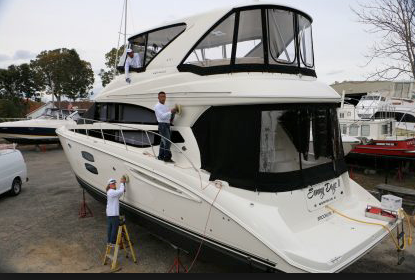It’s that time of the year again, and you need to start thinking seriously about getting your boat ready for the water, assuming you’re not one of the fortunate people who live far enough south that you can keep boating all year round. For the rest of us, here’s a very comprehensive spring commissioning checklist from BoatUS:
SPRINGFIELD, Va., March 8, 2021 – Boat Owners Association of The United States (BoatUS) offers its updated Spring Commissioning Checklist to help boaters start the season right. The nation’s largest advocacy, service and savings group also offers BoatUS.com/Spring, a new one-stop-shop for everything you need to know about the yearly ritual of recreational boat commissioning. A PDF copy of the checklist is available to download, print, and take to the boat with you. Be sure to follow all manufacturer recommendations for your specific boat, engine and accessories.
Before You Launch
- Inspect all around the hose clamps for rust and replace as necessary. Double clamp fuel lines and exhaust hoses with marine-rated stainless steel hose clamps. While not technically required, it’s wise to double clamp whenever possible on all hoses − especially those below the waterline.
- Inspect all hoses for stiffness, rot, leaks and cracking, and replace any that are faulty. Make sure they fit snugly.
- Inspect prop(s) for dings, pitting and distortion. Make sure cotter pins are secure.
- Grip the prop (on inboard drive systems) and try moving the shaft up and down and side to side. If it’s loose and can be wiggled, the cutless bearing may need to be replaced.
- Check the rudderstock to ensure it hasn’t been bent. Operate the wheel or tiller to ensure the steering works correctly. Check the rudder bearing for unusual play or movement.
- Inspect the hull for blisters, distortions and stress cracks.
- Make sure your engine intake sea strainer (if equipped) is not cracked or bent from ice and is free of corrosion, clean and properly secured.
- With inboards, check the engine shaft and rudder stuffing boxes for correct adjustment. A stuffing box should leak no more than two or three drops each minute when the prop shaft is turning. Check the shaft log hose for deterioration and rusty hose clamps.
- Inspect, lubricate and exercise seacocks.
- Use a garden hose to check for deck leaks at ports and hatches. Renew caulk or gaskets as necessary.
- Inspect and test the bilge pump and float switch to make sure they’re both working properly. Also inspect the pump’s hose.
- Check stove and remote LPG tanks for loose fittings, leaking hoses and properly functioning shutoff systems. Use the pressure gauge to conduct a leak down test to check for system leaks. Read more:
https://www.boatus.com/news-room/release/the-essential-boatus-spring-commissioning-che




